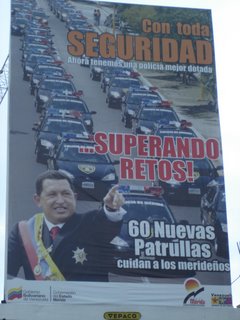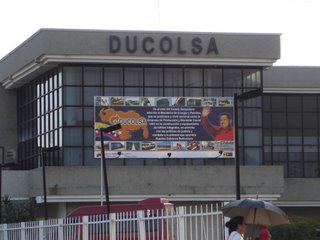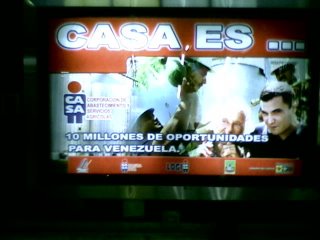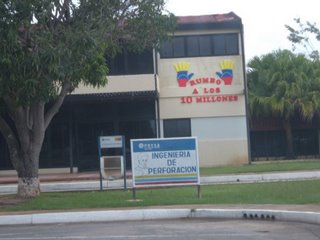While travelling through my hometown of Maracaibo and Caracas in late September, I was shocked to witness first-hand how government ads and banners almost always contain a Chávez photograph and his name. I had been warned about this, and the pictures I had been receiving from brave Venezuelans seemed to confirm it, but it doesn't hit you as bad until you see the signs everywhere you go.
Governments don't usually have to advertise themselves in quite this fashion. After all, social programs don't usually require massive advertising. Have you ever seen a huge banner for
Head Start in the US? How about the
Peace Corps? Would banners advertising these programs display a picture President Bush? Probably not, considering their websites don't display Mr. Bush. Would they list his name anywhere? Does the US government advertise using the President's image just months before a Presidential election? Shouldn't social programs advertise how people can access them, or what they offer, instead of who is putting them in place?
All of this happens in Venezuela on a massive scale. In the highways and roads I drove through, the government was clearly the most advertised entity in the country.
Even if one were to justify the government having to advertise, say, its foreign policy or its infrastructure programs, it was clear the main purpose of all these ads was to show Mr. Chavez and directly link him to everything the government does. All the ads I picture below were clearly paid for by some government entity, leaving no room for doubt as to who was paying for them. The debauchery, the pride they obviously take in being able to get away with it, is quite obscene. A country with independent, functional electoral authorities would surely ban this sort of stuff, don't you think?
But don't take my word for it - judge for yourself. I apologize if the quality of the pictures is not ideal - I took the pictures from moving vehicles - but I think the point is clear in all of them.

This is a car belonging to Maracaibo City Hall. The picture was taken in early October in the parking lot of Maracaibo's Sambil shopping mall (not a hotbed of revolutionary communism by any standard). The car has a picture of Maracaibo Mayor Di Martino as well as Chávez, 20 pounds lighter. The slogan reads "Fatherland and life", which is curious given that the rallying cry of the revolutionary left has always been "fatherland or death!" Does this mean they won?
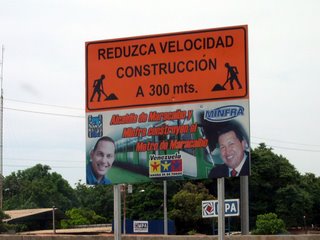
When you drive from Maracaibo to the airport, you see a lot of construction for the
Maracaibo Metro. I won't get into the discussion of whether or not a city like Maracaibo, without a functioning bus system and only 1.6 million people spread out in an extended plain, actually needs an expensive subway system.
The picture above is jointly paid for by the
Infrastructure Ministry and Maracaibo's (chavista)
City Hall. It pictures Chávez and Maracaibo Mayor Giancarlo Di Martino, and proudly announces that "Maracaibo City Hall and the Infrastructure Ministry are building the Maracaibo Metro." It also shows the "banner" of the Chavez government, the sign with the three people holding hands saying "Venezuela now belongs to all of us." In the background, the green Metro trains are harder to make out.
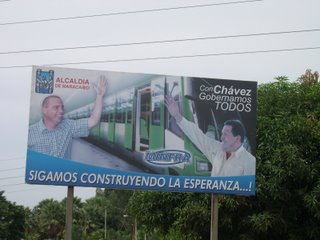
A few meters down the road, as if to drive the point home, we are again reminded that Chávez and Di Martino are (perhaps personally?) building a Metro. The text reads "Let us continue building hope...!", reminding the voter that Chávez wants to "continue building hope"
until 2030, at least. In the upper right-hand corner we see another government lemma, "With Chavez, we all govern." How institutional! Again, the ad is clearly paid for by City Hall and the Infrastructure Ministry.

A few more meters down the road, a similar ad showing Di Martino and Chavez in the same poses. This time, the ad is to advertise the
Copa America, the South American soccer tournament set to take place in 2007. Maracaibo is one of the host cities, as is implied in the text and in the soccer players you can see in the background.
However, the main message in the ad is that Di Martino and Chavez seem to, personally, be responsible for bringing the cup to the city. Chavez's slogan is also clearly visible in the ad.
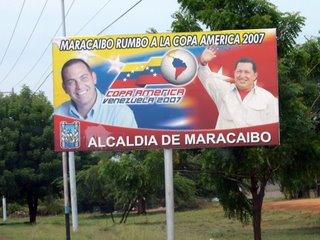
And yet another hundred meters or so down the road, the point about the soccer tournament is reinforced. Chávez is shown wearing red-hot electoral gear, only this time they do not even bother to show people actually playing soccer. I should mention that
the stadium where the cup will be played is at least 10 kilometers from where this ad is placed.

When you start getting closer to the airport, you even begin to see Chavez's image on street signs! The above picture is of a sign signalling an important intersection. The banner in the middle is the logo of Maracaibo City Hall, and on the left you see a picture of Chávez and Di Martino handing out some sort of housing solution. The text again says "Let us continue building hope...!" The gall of using public funds to advertise the Chávez government's accomplishments in housing is doubly offensive when you realize that housing is one of the areas where the government's record
is most disappointing, as admitted by even Chávez himself.

Once you reach
Maiquetía airport and begin the slow, winding drive into the city, you notice that the focus of the government seems to be on foreign policy. This struck me as an unorthodox electoral strategy, but what do I know?
The above sign shows Chávez with Chinese President Hu Jintao, and it reads "Breaking the blockade, Venezuela deserves respect!" This slogan was visible in many other signs on that road, as will be evident in the paragraphs below.
As for the content of the slogan, I was left wondering what blockade the government is referring to since Chávez sells millions of barrels of oil per day to the US. My guess is that it's either the Cuban embargo, or some sort of diplomatic blockade that the Venezuelan government believes the US government is enacting.
Finally, it is not clearly visible, but the ad displayed the government's logo.

The above picture, visible a few meters after the previous one, is an ad for
Misión Ribas. This social program is, in theory, in charge of granting high school diplomas to all those adults who failed to get it when they were in school. While its goal is admirable, the government's claim of having reached 250 thousand people per year seems ambitious and has so far not been verified by any independent entity.
The sign is paid for by Venezuela's state oil-giant
PDVSA, and it reads "With Chavez, the people govern"; "Mision Ribas is an act of liberation"; "250,000 integral high school graduates"; "4th graduating class, Victory is necessary"; "Toward the construction of socialism." Again, the ad is red-hot (the color of Chávez's political party), and it features a smiling Chávez next to Oil Minister Mr. Ramírez and a Native Venezuelan activist. It also features a picture of
José Felix Ribas himself. I'm sure his heirs appreciate the free publicity.
One is left wondering whether the goal of Misión Ribas is to graduate those left out by the system and actually give them tools to survive in a globalized world, or rather to "construct socialism."

The picture above is a few hundred meters after the previous one, and it shifts the focus back to foreign policy. Again, the mysterious blockade is mentioned, and it features a picture of a smiling Chávez and Malaysian Prime Minister Badawi. While I tend to be well-versed in foreign affairs, I had never seen a picture of the Malaysian Prime Minister. It's strange that my first encounter with his likeness is a giant billboard outside Caracas International Airport. I wonder what the Malaysian government feels about participating in an illegal campaign ad in our country. Their
dismal record in human rights suggests they probably don't care.

Further down the road, another prominent ad featuring Chavez with the Presidents of Uruguay, Brazil, Argentina, Paraguay and Chile, as well as the foreign minister of Mexico and an old man who used to be dictator of Cuba. I was particularly shocked to see the Chilean President in this ad given that I live in Santiago and I have not seen a billboard with her face on it since the campaign ended in January.
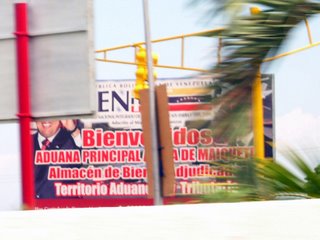
The above picture was, regrettably, partially blocked. Still, you can make out Chávez's grin welcoming the visitor to the main customs area at Maiquetía International Airport which, I believe, is technically under the control of the
National Guard. The billboard comes to you courtesy of
Seniat, our local tax-collecting office. In other words, it was paid for by you and me.
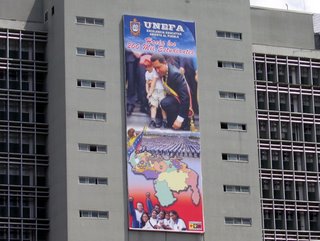
And finally, the
pièce de résistance. My friends in Caracas had told me about this ad, and it took on mythical proportions in my imagination. Seeing it the first time made my skin crawl.
The ad is placed on the side of the former headquarters of PDVSA in Chuao, one of the main business districts in Caracas. This is also the home of some of the city's most notorious traffic jams.
The building now houses the
University of the Armed Forces, which I assume makes it a military installation. The huge banner of Chávez holding a small child reads "University of the Armed Forces - Educational excellence open to the people - Toward 200,000 students." It also shows a map of Venezuela and a portion of
what is currently Guyana annexed to it. I don't know, but if I'm the Guyanese government and I see a military building showing a part of my country as belonging to Venezuela, I would be worried. I guess the Guyanese are used to these chest-thumping displays on the part of Venezuelans.





